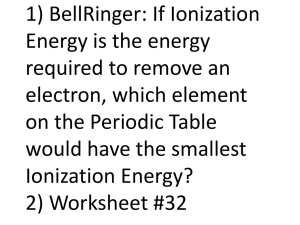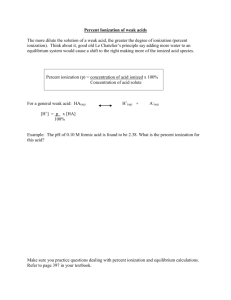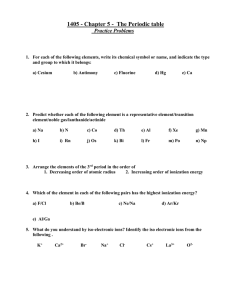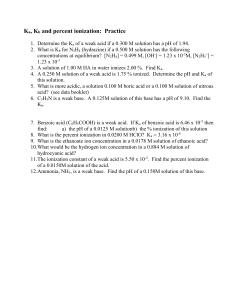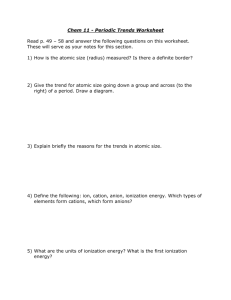EPSC2013-1030 - CO Meeting Organizer
advertisement
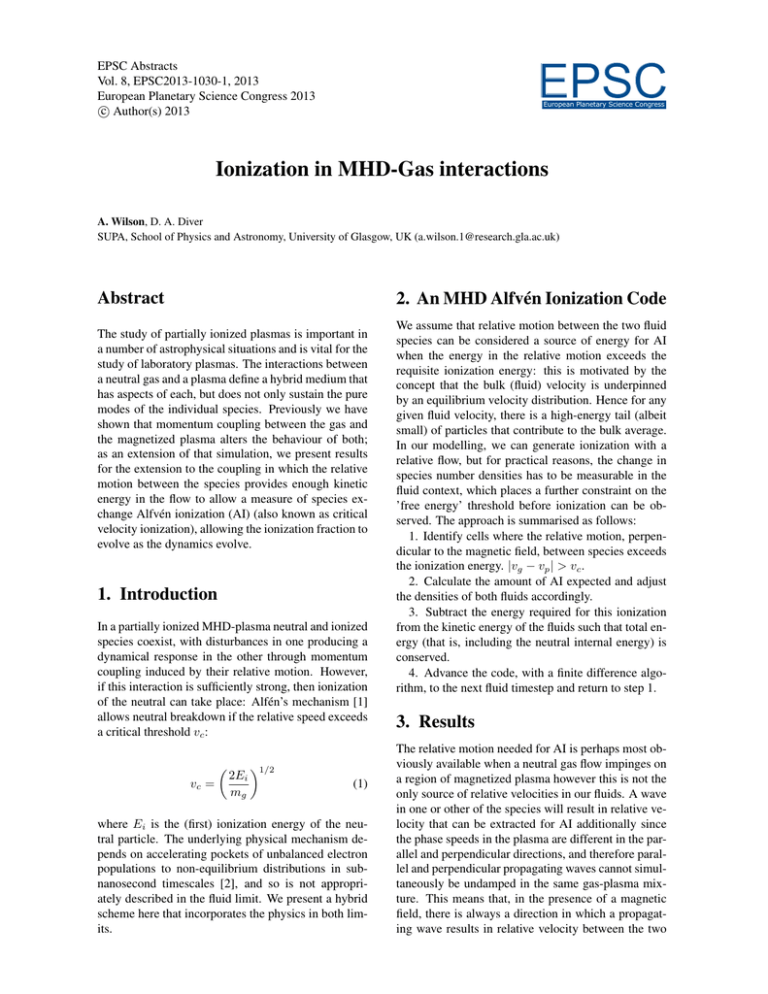
EPSC EPSC Abstracts Vol. 8, EPSC2013-1030-1, 2013 European Planetary Science Congress 2013 c Author(s) 2013 European Planetary Science Congress Ionization in MHD-Gas interactions A. Wilson, D. A. Diver SUPA, School of Physics and Astronomy, University of Glasgow, UK (a.wilson.1@research.gla.ac.uk) Abstract 2. An MHD Alfvén Ionization Code The study of partially ionized plasmas is important in a number of astrophysical situations and is vital for the study of laboratory plasmas. The interactions between a neutral gas and a plasma define a hybrid medium that has aspects of each, but does not only sustain the pure modes of the individual species. Previously we have shown that momentum coupling between the gas and the magnetized plasma alters the behaviour of both; as an extension of that simulation, we present results for the extension to the coupling in which the relative motion between the species provides enough kinetic energy in the flow to allow a measure of species exchange Alfvén ionization (AI) (also known as critical velocity ionization), allowing the ionization fraction to evolve as the dynamics evolve. 1. Introduction In a partially ionized MHD-plasma neutral and ionized species coexist, with disturbances in one producing a dynamical response in the other through momentum coupling induced by their relative motion. However, if this interaction is sufficiently strong, then ionization of the neutral can take place: Alfén’s mechanism [1] allows neutral breakdown if the relative speed exceeds a critical threshold vc : vc = 2Ei mg 1/2 (1) where Ei is the (first) ionization energy of the neutral particle. The underlying physical mechanism depends on accelerating pockets of unbalanced electron populations to non-equilibrium distributions in subnanosecond timescales [2], and so is not appropriately described in the fluid limit. We present a hybrid scheme here that incorporates the physics in both limits. We assume that relative motion between the two fluid species can be considered a source of energy for AI when the energy in the relative motion exceeds the requisite ionization energy: this is motivated by the concept that the bulk (fluid) velocity is underpinned by an equilibrium velocity distribution. Hence for any given fluid velocity, there is a high-energy tail (albeit small) of particles that contribute to the bulk average. In our modelling, we can generate ionization with a relative flow, but for practical reasons, the change in species number densities has to be measurable in the fluid context, which places a further constraint on the ’free energy’ threshold before ionization can be observed. The approach is summarised as follows: 1. Identify cells where the relative motion, perpendicular to the magnetic field, between species exceeds the ionization energy. |vg − vp | > vc . 2. Calculate the amount of AI expected and adjust the densities of both fluids accordingly. 3. Subtract the energy required for this ionization from the kinetic energy of the fluids such that total energy (that is, including the neutral internal energy) is conserved. 4. Advance the code, with a finite difference algorithm, to the next fluid timestep and return to step 1. 3. Results The relative motion needed for AI is perhaps most obviously available when a neutral gas flow impinges on a region of magnetized plasma however this is not the only source of relative velocities in our fluids. A wave in one or other of the species will result in relative velocity that can be extracted for AI additionally since the phase speeds in the plasma are different in the parallel and perpendicular directions, and therefore parallel and perpendicular propagating waves cannot simultaneously be undamped in the same gas-plasma mixture. This means that, in the presence of a magnetic field, there is always a direction in which a propagating wave results in relative velocity between the two fluids. [3] Figure 1 shows an initially spherically symmetric acoustic wave set off in the gas propagating outwards from the centre, the magnetic field is in the horizontal direction. The relative motion between these species induces some measure of AI with the new plasma created by this ionization shown in fig 2. Most of the ionization takes place near the disturbance before AI and momentum coupling between the species has damped the wave amplitude below vc . The anisotropy in this example is partly a consequence of the anisotropy in the AI process - with only perpendicular motion inducing ionization - and also due to the new overdensities of plasma being a source for new waves to propagate through the computational domain. Figure 2: A density map of the new plasma created by the spherical bomb in figure 1. It contains all the plasma created by the ionization front up to this time. References [1] Alfvén, H.: Collision between a nonionized gas and a magnetized plasma’, Rev. Mod. Phys Vol. 32, 1960 [2] MacLachlan, C. S., Diver, D. A. and Potts, H. E.: The evolution of electron overdensities in magnetic fields, N. J. Phys. Vol. 11(6), 063001, 2009. [3] Diver, D. A.., Potts, H. E., and Teodora, L. F. A.: Gas-plasma compressional wave coupling by momentum transfer, N. J. Phys., Vol. 265(8), 2006. Figure 1: A snapshot of a spherically symmetric wave generated in the neutral. The relative motion caused by this wave is used to drive AI. 4. Summary and Conclusions We have demonstrated a technique for incorporating Alfven ionization into an MHD-neutral gas interactions code. This technique is consistent energetically and with both the fluid models and the physics of AI itself. This technique could be utilised to understand the behaviour of any partially ionized magnetized plasma both for astrophysical, such as brown dwarf atmospheres [4], the solar photosphere [5] or even Sun impacting comets [6] as well as laboratory plasmas such as neutral pellet injection in fusion tokamaks [7]. [4] Stark, C. R., Helling, Ch., Diver, D. A. and Rimmer, P.: Ionization in Atmospheres of Brown Dwarfs and Extrasolar Planets V: Alfvén Ionization, In preparation, 2013. [5] Diver, D. A., Fletcher, L. and Potts, H. E., ‘Fip enhancement by alfvén ionization’, Sol. Phys., Vol. 227(2), 2005. [6] Brown, J. C., Potts, H. E., Porter, L. J. and Le Chat, G.: Mass loss, destruction and detection of Sun-grazing and -impacting cometary nuclei, A&A Vol. 535, A71, 2011. [7] Lalousis, P. J., Lengyel, L. L. and Schneider, R.: Two (’plus one’)-dimensional simulation of pellet cloud evolution in the poloidal plane with a prescribed neutral particle source strength, Plasma Phys. Control. Fusion, Vol. 50, 085001, 2008.
